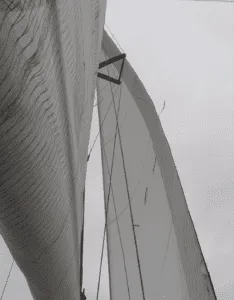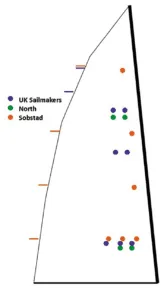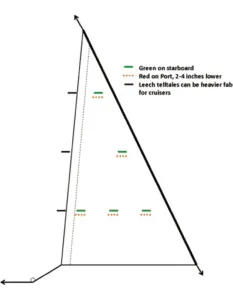Telltales on the body of the jib and leech of the main are commonplace, and most of us learned to sail using them. They tell us at a glance whether the air flow is attached or stalled at that location. Most commonly, they are placed at the forward third of the jib and the leech of the mainsail.
When a windward telltale lifts, it signals that the jib is about to luff. When a main leech telltale wraps behind the sail, this usually means the main is oversheeted, and the aft section is beginning to stall. We generally don’t bother with body telltales on the main; the windward telltale is too affected by mast turbulence to be meaningful, and the leeward telltale will always stream because of wind blasting through the slot.
But what about the jib leech? The forward leeward telltale will flutter when sail is completely stalled, but it doesn’t warn of impending stalls (see “Adding Yarn Telltales to Your Sails,” PS May 2018).
The most important function of leech telltales is detecting the onset of stall near the head of the sail due to insufficient twist. They are seen in racing classes, most commonly on one designs like the Interlake, J-22, Laser 4000, and Lightning. Typically, only one is needed, in the top 1/3 of the sail. But they have downsides that limit their popularity on cruising boats.

LIMITATIONS
They work best on non-overlapping head sails. Because the air path is long, and unlike the main, it does not have another sail cleaning up the airflow on the back side, the after third of the genoa is often slightly turbulent when trimmed for maximum power. Telltale durability is limited because they fly off the back of the sail, where they flap constantly even when furled, are not protected by the sun cover, and drag across the shrouds during every tack. The sail must be lowered to replace them, and furlers make us lazy about that.
Jib leech telltales are generally impossible for the helmsman to see. Unless a trimmer is stationed at the forward, leeward corner of the cockpit they are hard to check. On an old sail with a hooked leech or leech line that is too tight, they may never stream. They are helpful with opaque sails, because you don’t need to see through the sail.
A DIFFERENT READ
Reading jib leech telltales is slightly different from mainsail leech telltales. First, changes are more abrupt. The main leech telltales go from 100% to 90% to 80% streaming over a considerable range of wind angles, because the jib provides some stabilizing flow over the back of the sail. The lee side of the jib does not have this assistance and stalls more abruptly. Just a few clicks of the winch or the smallest steering change cause them to stall 100 percent.
A slight stall on the uppermost mainsail leech is sometimes a good thing when seeking maximum power. The same is never true on the jib. Over trimming the jib will slow you more than over trimmed main, because it chokes off flow to the main. The upper jib leech telltales should be streaming 90-100 percent of the time.
CONCLUSIONS
We like them, because we like tweaking our boat and pulling strings. Keep that upper jib leech telltale streaming 90-100 percent of the time. The upper most main leech telltales can stall more often, particularly when powered up. A no-hurry cruiser may well not see the value. But every seamanlike cruiser becomes a racer in strong weather, when he must wring every bit of lift out of reefed sails to push into building waves. It’s not about speed, it is about control and weatherliness.

1. Telltale locations vary not only by sailmaker, but also by sail design and boat. The illustration shows telltale locations chosen by leading sailmakers, as seen at a recent one-design C Scow regatta.

2. Two to four inches should separate the color-coded port (red) and starboard (green) telltales in each pair, so that both are clearly visible. Leach telltales can be heavier fabric for cruisers.




































